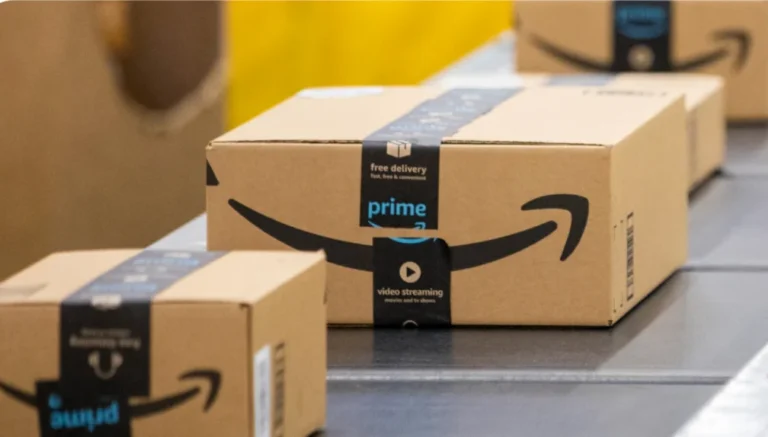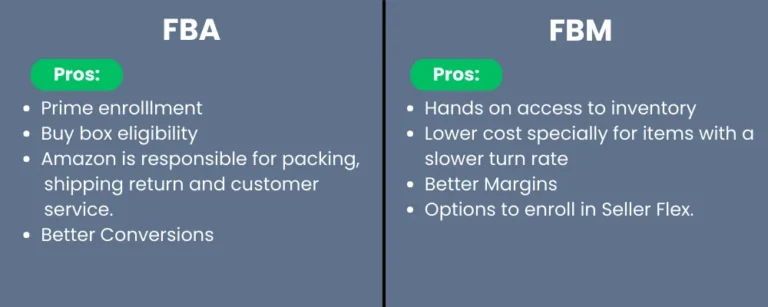What does FBA stands for?
FBA (Fulfilled by Amazon) is a service given by Amazon whereupon the sellers supply their products to Amazon warehouses and the company is responsible for the products shipping. Following that, you sell the product on Amazon and Amazon takes up the role of owning, packing, and even delivering the product, apart from providing customer support. Another advantage of employing FBA is that it frees up the time of the sellers in the undertaking of specific logistics tasks, while they focus on other areas of their operations.
FBA is on the rise among the sellers because it also simplifies operations and helps products get Amazon Prime badge, which has many customers in India.

Advantages of Fulfillment by Amazon:
Prime Eligibility:
One of the best Advantage of FBA is your products become eligible for Amazon Prime. This immediately gives your products a market over non-Prime products since customers gravitate towards products that qualify for Prime for the convenience, reliability, and free shipping included. In return, this might mean more visibility for vendors and better chances of conversions. If a seller gets a Prime badge then it helps in increasing the sales volume up to a great extent.
Time-saving:
Ordering, stocking, dispatching, and responding to customer inquiries can be very time-consuming, especially for growing companies. As observed, with FBA, the challenging tasks are undertaken by Amazon. Instead of getting involved in tasks concerning storage of items and selection, packaging of items, and distribution of items to buyers, Amazon handles the same once your items are at their fulfillment centers. This is especially advantageous for the sellers who have an aim at improvising on the business or come up with new products in the market.
Customer Support and Refunds:
One more benefit of FBA is that customers receive the delivery and logistics services from Amazon with exceptional customer services. It is from receiving inquiries to managing returns, Amazon handles everything on your behalf. One activity that causes a great deal of stress and concern for selling online is customer service and when sellers outsource this service to Amazon, it will be of great benefit. In addition to what has been stated, Amazon also had an easy return policy, which would ensure shoppers in the Indian market that their money is safe and they can return their items if they do not like their product.
Scalability:
Another advantage of FBA is scalability because From FBA, sellers can increase their business without worrying about the shipment. With this growth in sales, Amazon handles the extra order traffic without necessarily needing you to invest in additional assets such as warehouses or hiring other employees. This makes FBA ideal for the sellers and they can build their business fast using Amazon Fulfilment Service. This means that whether you have a lot of orders to fulfil or are a relatively small seller just starting out on Amazon, the fulfillment system can be used by any seller.

Difficulties faced in Fulfillment by Amazon (FBA):
Expenses:
While FBA has its benefits, FBA comes with the added price of convenience. In case inventory stays in Amazon’s warehouses for a rather long time, sellers have to pay for storage fees, fulfillment fees, as well as additional fees related to long-term storage. These costs can occur frequently and when they do, if your products’ profit margins are thin, the charges add up quickly. FBA can negatively impact your profit margins, and if not managed carefully, may result in a loss for your business instead of boosting sales.
Inventory Management:
For FBA sellers, inventory control is a vital parameter thus needs to be well planned. Amazon raises the selling fees for items that take a long time to sell in the facility. If you own goods that take a long time to sell, long term expense of storing them can reduce profitability. Forecasts on the inventory and restocking is very important to avoid making unnecessary charges on the business.
Less Control:
Selecting Amazon Fulfillment also means that it will be partially handling your product packaging and shipping of your products. The only disadvantage of not having control if branding is done using packaging or if the sellers like to handle their customers’ issues by themselves. As it has been established that Amazon has a strong management of its logistics there is less flexibility for customization.

What does Fulfillment by Merchant (FBM) mean?
Fulfillment by Merchant (FBM) is common and is a more complex model in which the sellers directly manage the fulfillment process. This means that you are required to maintain your own stocks, packaging and shipping your products and be in charge of customer relations. They are more manual but give sellers full control of their business, which may be reason enough for some sellers to opt for FBM.
That is why, for instance, FBM may be a more cost-effective way to sell particular products: if the seller already has the necessary warehouses and logistics or if their products do not fit the parameters required for the FBA program.

Benefits of FBM:
Control Over Operations:
The primary advantage of FBM is that it leaves all authority within the hands of sellers. FBM provides sellers with flexibility over all details, including product packaging and transportation control. This is especially useful for merchants who value personalized customer service or struggle to maintain consistent product delivery.
Lower Fees:
As compared to FBA in which sellers are charged by Amazon for storage and picking and packing, FBM does not have these costs. Some sellers who sell huge or bulkiest products may ultimately end up paying more storage fees that FBA offers. Besides, the FBM is ideal for sellers with small units of price, who don’t want to incur additional costs associated with the FBA.
Flexibility:
FBM offers the opportunity for much more flexible management of your stock and delivery. Sellers have the option to choose the cheapest shipping options possible, customize the buyer experience and perhaps offer faster local delivery to some regions. Fulfilment by Merchant (FBM) FBM is useful for products requiring special processing or delivery which cannot be accomplished with FBA.
More suitable for bulky or low-profit items:
Fulfillment by Merchant may be most appropriate with larger, awkward or dense items or indeed items that have little margin for profitability. FBA increases fees for the storage and shipping of large items, impacting overall profits. The decision to manage the fulfillment of these products on your own could be cheaper than hiring a third-party.

Challenges of FBM:
Management of logistics:
Sellers who choose Fulfillment by Merchant (FBM) have complete control of fulfillment on their own. This means they must handle the storage and packaging of their products as well as shipping and processing of returns as these are tasks that single business need to undertake exercising their logistics. Direct merchants have the option of selecting Amazon Easy Ship or shipping via Self-Ship.
Amazon Easy Ship:
Amazon Easy Ship gives the seller an opportunity to request pickups through the Seller Central, and the transportation partners pick the order from the warehouse and deliver it to the customer, hence making it easier.
Self-Ship:
Self-Shipping is a process in which sellers carry out the shipping process on their own by seeking the assistance of third-party logistics providers like Delhivery or Blue Dart, etc. In this case, the seller has to coordinate the pickups, sort out shipments and interact with outside delivery services.
While Amazon Easy Ship makes the process easier for simplicity’s sake, self-shipping allows for even more versatility at the cost of extra work and planning. Small sellers also may lack the capacity to manage their own shipping, and the growth in the size of orders received can complicate the delivery process.
Less Visibility on Amazon:
FBM listings on Amazon are less noticeable because FBM listings do not have Prime status that enable them to be seen by the customer in preference to the FBA listings. Many shoppers make their decision to buy only Prime-eligible products due to fast and free delivery. In India, there are many buyers online who are getting registered as amazon prime members very rapidly so if any seller is not eligible for amazon prime than his potential market and his sales is also getting limited.
Customer service responsibility:
He added that with FBM, you are automatically responsible for customer service and returns. While it seems to offer better monitoring and control it may escalate your work load especially where you receive many customer complaints or returns. For instance, sellers who are unable or willing to commit time and effort towards the achievement of these goals may experience a decline in customer service.
Analyzing FBA and FBM to some extent
In some cases, choosing between FBA and FBM presents a clear distinction with choices that are easier to make. Yes, most of the time every model has its own pros and cons so selection of the right one depends on the needs of the business. To help you easily understand the differences between the two models, here are some comparisons.
1. Costs:
FBA Costs: One of the more significant aspects that sellers need to be aware of when using FBA is costs to be paid and they are rather diverse. Storage costs also depend on the volume as well as the time span your goods are stored at Amazon warehouses. The cost of delivering orders depends on the size, weight, and type of product as well as fees applied for holding products that remain on the marketplace for long. Such costs could quickly add up especially on goods that are not moving off the shelves, or are bulky.
FBM Costs: Although FBM wipes out storage and fulfillment fees, you will have to bear the cost of storage space, packing, and logistics. FBM sellers have to even pay for packaging, shipping carrier fees and storage, which depends on the dimensions and weight of the product. While it is true that FBM may be more affordable in terms of costs for certain products, logistics become internal and may become more cumbersome as your business expands.
2. Control and Flexibility:
FBA: With FBA, Amazon handles most of the process which means you have limited control over handling, packaging and shipping of your products. While some sellers may not have issues with this limited control, others who look forward to branding their products for differentiation will consider this as a constraint. Amazon has strict packaging rules that eliminate the ability to use custom packaging that supports your brand image.
FBM: FBM sellers using Amazon’s Easy Ship service must package their products in Amazon-branded packaging. However, with the Self-Ship method, sellers have complete control over their operations, including the freedom to use their own branded packaging and shipping methods. This flexibility allows them to create unique customer experiences, stand out from competitors, and manage their brand image effectively.
3. Customer Service and Returns:
FBA: Everyone knows that FBA has an edge because of its ability to qualify for Amazon Prime. Amazon’s prime customers expect fast, reliable, and sometimes free shipping and adding the Prime logo to your products will add significant sales boosts. In a country like India, where the number of people opting for Prime subscriptions is increasing, speedy delivery can be an advantage. Amazon optimizes its network for order fulfilment for quicker delivery which tends to increase customer satisfaction leading to better reviews.
FBM: Delivery time of your shipment will be decided by the chosen carrier and the distance of your delivery to a customer. Sellers who opt for their own shipping do not offer the fast delivery of goods as offered by Amazon. However, FBM vendors who have a good supply chain and need not rely on using Amazon’s logistics services can deliver their products quickly, especially to their targeted or neighbouring regions.
4. Scalability:
FBA: Its destiny was planned; FBA was designed to be scalable. Whether you are dealing with ten orders weekly, or one thousand, Amazon can handle any additional workload without your help. FBA is advantageous when a seller wishes to grow quickly because with FBA; he or she does not have to purchase additional space, hire more employees, or deal with complicated logistics.
FBM: Due to this, to scale up with FBM, therefore, will require a bigger investment in infrastructure. The increase in sales volume means that the size of the warehouse will need to expand, more manpower will have to be hired, and capital expenditure on software or systems that enable order processing and tracking of the inventory will also have to be incurred. While FBM gives control and flexibility, the expansion of this strategy is costly and time-consuming, most especially for fast-growing organizations.
5. Customer Service and Returns:
FBA: Amazon sellers who use the FBA programme have the company deal with customer support and returns since it enhances customer experience. This comprises of handling questions, complaints, refunds, and exchanges. This leads to sellers having to worry less about paperwork and more about growing their business. One more strong source is customer service as Amazon provides quality and relevant help for their clients which further contributes to the generally increasing buyer satisfaction.
FBM: FBM sellers are fully responsible for the management of customer service and returns. Poor customer relations are also implications of shortages as clients can provide negative comments that can affect your standing on Amazon. Indian sellers have to ensure that they have adequate structures to meet customer call demand since customer service standards are high in this market.
6. Shipping Speed and Customer Experience:
FBA: However, when comparing the two strategies, FBA is preferred for several factors, but the most important one is access to Prime. Customers of Prime know that they are getting fast, reliable, and sometimes even free shipping, and incorporating Prime logo on products can really boost sales. In India, where more and more customers are opting for Prime subscriptions, delivery quickens can be a point of difference. The logistic network of Amazon tend to be built for delivering as faster and this will lead to increased sales and hence potentially better reviews.
FBM: The delivery time of your shipment through FBM depends on the availability of the carrier you choose or the distance between you and your customer. Sellers who arrange the shipping themselves may not offer the same efficiency that Amazon has, this may slow down shipping. However, for those FBM vendors with a set logistics infrastructure in place the delivery time can remain efficient, particularly for customers in specific geographic locations or areas close to the delivery location.
A Hybrid Approach: Combining FBA and FBM
Some retailers have discovered that it is possible to obtain advantages from both FBA and FBM selling strategies. Choosing both fulfillment methods allows sellers to cut on costs; manage their stock efficiently; and, when necessary, draw on Amazon’s fulfilment centers.
For instance, you can use FBA for low-cost, highly-margin products that move very fast through the Amazon selling system because they feature the Prime logo and guarantee fast and affordable delivery. At the same time, FBM can be used for larger, larger-sized goods or goods that do not require urgent shipment to the customer, thus minimizing costs for storage and delivery.
A combination model allows you to adapt your fulfillment strategy to your specific needs and characteristics of your business as well as the type of goods you are selling, thus helping you enhance your profitability per cent by decreasing costs.

How to Switch Between FBA and FBM
Making the transition between FBA and FBM can easily be accomplished through your Seller Central website. This is the process to change:
Make changes in your listings: To convert FBA to FBM or vice versa, simply visit the “Manage Inventory” section on Seller Central. It is also helpful to know that for every single product you have the ability to customize the fulfillment settings as you see fit.
Establish Shipping: When moving from FBA to FBM one has to set shipping options like rates and delivery frequencies. Check to make sure your shipping options are appropriate to either enhance the buyer experience while minimizing costs.
Monitor your performance:
Keep on closely monitoring your performance indicators after the transition. These are the key considerations when the use of FBA: One ought to be careful of the costs of storage and customer reviews. Check the FBM delivery time and ensure that your customer service complies with Amazon standards.
Conclusion:
Picking between FBA and FBM is a complex decision that shall influence your store’s performance, consumers satisfaction, and profitability. The two delivery formats have their advantages and disadvantages and depend on the type and value proposition of the business plans, products, and growth strategies.
FBA makes it convenient, easy to scale, and gets products in front of Prime customers which makes FBA ideal for high-volume or companies looking to grow quickly. However, FBM provides the higher control, flexibility and cost saving, particularly to the sellers who own the logistics channel of their own or who sell the high bulky and low margin products.
Finally, it is suggested that Amazon can use both FBA and FBM to the maximum in order to make them even more efficient and profitable. When choosing your model, we must consistently evaluate your fulfilment approach and make changes because your business evolves over time as does the market for Amazon India.
Additional Resources:
1.Fulfilled by Merchant – https://sell.amazon.com/programs/fulfilled-by-merchant
2.Benefits of Becoming an Amazon Prime Seller – https://sell.amazon.in/seller-blog/benefits-of-becoming-an-amazon-prime-seller
3.Fulfilled by Amazon – https://sell.amazon.in/shipping-and-fulfillment/fulfillment-by-amazon
4.How to Become a Successful Amazon FBA Seller –ultimate-guide-how-to-become-a-successful-amazon-fba-seller

